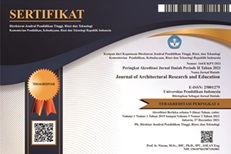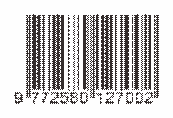EXPLORING THE ELEMENTS OF BRICOLAGE AS CREATIVE PRODUCT
Abstract
Product, a critical component of creativity, was explored within a creative setting by concentrating on bricolage as deemed implicit components of creativity. This study's major objective is to represent elements of bricolage as product creativity in a design studio. This study's primary objective is not to increase the efficacy of product creativity, but rather to accurately make a new description of the elements of product creativity based on the notions of bricolage. An experiment was performed with 25 student works designed as the part of the assignment titled `inform/perfom` in basic design studio. Rating scales were utilized as evaluation instruments.Considering the product creativity as bricolage, it was found that there is statistically significant relation between design elements, design principles and material utilization. Moreover, compared to design principles, design elements have a higher ratio of creative level in student works.
Keywords
Full Text:
PDFReferences
References
Amabile, T. M. (1983). The social psychology of creativity. New York: Springer.
Baket, T., & Nelson, R. (2005). Creating Something from Nothing: Resource Construction through Entrepreneurial Bricolage. Administrative Science Quarterly, 50, 329–366.
Blankenship, B. (2020). Bricolage and Student Learning. A Practice Report. Student Success, 1-5.
Bouvier-Patron, P. (2021). Bricolage – From Improvisation to Innovation: The Key Role of “Bricolage”. In D. Uzunidis, F. Kasmi, & L. A. (eds.), Innovation Economics, Engineering and Management Handbook 2: Special Themes, (1st ed., pp. 67-73). USA: ISTE Ltd and John Wiley & Sons .
Gerber, E. (2007). Improvisation Principles and Techniques for Design. CHI 2007 Proceedings. Learning & Education ,(pp. 1069-1072). San Jose, CA, USA: CHI.
Hasirci, H., & Demirkan, H. (2017). Understanding the Effects of Cognition in Creative Decision Making: A Creativity Model for Enhancing the Design Studio Process. Creativity Research Journal, 19(2-3), 259-271. DOI: 10.1080/10400410701397362.
Johnson, C. (2012). Bricoleur and Bricolage: From Metaphor to Universal Concept. Paragraph , 35.3, 355-372.
Karabıyık, H. E. (2022) Bricolage in design research: A study on studio practice. (Master’s thesis.), Eskisehir Osmangazi University, Department
Kay, L. (2016). Research as Bricolage: Navigating in/between the Creative Arts Disciplines. Music Therapy Perspectives, 34(1), 26–32. doi:10.1093/mtp/miv041.
Kincheloe, J. (2005). On to the next level: Continuing the conceptualization of the bricolage. Qualitative Inquiry , 11 ( 3), 323-350.
Kini-Singh, A. (2023). From Anthropology to Artistic Practice: How Bricolage Has Been Used in the Twentieth Century as an Ideal Model of Engagement with the World. Journal of Human Values, 29(1), 48–57. https://doi.org/10.1177/09716858221130130.
Klerk, S. (2015). The creative industries: an entrepreneurial bricolage perspective. Management Decision, 53(4), 828-842.
Le Loarne, S. (2005). Bricolage versus Creativity: What`s the Difference? Bricolague as one face of Creativity. Bricolage and Re-Employment in Organizations. Working Papers, Berlin: EGOS Colloquium. Retrieved February 20,2023 , from http://hal.grenoble-em.com/hal-00451857/document
Levi-Strauss, C. (1994). The Savage Mind. Chicago : The University of Chicago Press
Louridas, P. (1999). Design as bricolage: anthropology meets design thinking. Design Studies, 20, 517–535.
Phillimore, J., Humphries, R., Klaas, F., & Knecht, M. (2016). Bricolage: potential as a conceptual tool for understanding access to welfare in superdiverse neighbourhoods. Birmingham: RiS Working Paper Series. Retrieved February 20,2023 , from https://www.birmingham.ac.uk/Documents/college-social-sciences/social-policy/iris/2016/working-paper-series/IRiS-WP-14-2016UPWEB3.pdf
Pierre, L. (2019). Designing for the everyday through thusness and irregularity. International Association of Societies of Design Research Conference 2019, Design Revolutions. Manchester : IASDR.
Real, P. (2008). Slums Do Stink: Artists, Bricolage, and Our Need for Doses of “Real” Life. Art Journal, 67(1), 82-99. DOI: 10.1080/00043249.2008.10791296.
Rogers, M. (2012). Contextualizing Theories and Practices of Bricolage Research. The Qualitative Report 17 (48), 1-17.
Rowe, C., & Koetter, F. (1978). Collage City. London: MIT Press.
Safina, A., Gaynullina, L., & Cherepanova, E. (2020). A Work of Art in The Space of Network Culture: Creativity as Bricolage. Creativity studies, 13(2), 257–269. https://doi.org/10.3846/cs.2020.12264.
Sarantou, M. (2018 ). Fashion Design: The Connective Role of Improvisation in New Learning Experiences. Universal Journal of Educational Research, 6(6), 1358-1364. DOI: 10.13189/ujer.2018.060627.
Scalbert, I. (2011). The Architect as Bricoleur. Journal of Architectural Knowledge No. 04, 69-88.
Schnelker, D. L. (2006). The Student-as-Bricoleur: Making Sense of Research Paradigms. Teaching and Teacher Education 22(1), 42-57.
Schön, D. (1983). The Reflective Practitioner: How Professionals Think in Action. USA: Basic Books.
Spychalska-Stasiak, J. (2020). Bricolage in Scientific Research Practice: An Attempt at Grasping the Meaning of the Concept. Quarterly, 2(128).
Tate Art Terms. (2023). Bricolage. https://www.tate.org.uk/art/art-terms/b/bricolage
Tian, H., Otchere, S. K., Dogbe, C. S., Addy, W. O., & Hammond, F. (2021). New Product Creativity Mediating the Relationship Between Organizational Bricolage and the Competitive Advantage of SMEs. Journal of Competitiveness, 13(4), 151–166.
Vallgarda, A., & Fernaeus, Y. (2015). Interaction Design as Bricolage Practice. TEI'15: Ninth International Conference on Tangible, Embedded, and Embodied Interaction (pp. 173-180). Stanford: Association for Computing Machinery.
Wu, L., Liu, H., & Zhang, J. (2017). Bricolage effects on new-product development speed and creativity: The moderating role of technological turbulence. Journal of Business Research, 70, 127-135.
DOI: https://doi.org/10.17509/jare.v5i2.56999
Refbacks
- There are currently no refbacks.
Copyright (c) 2024 Journal of Architectural Research and Education

This work is licensed under a Creative Commons Attribution-NonCommercial-ShareAlike 4.0 International License.
Statcounter

This work is licensed under a Creative Commons Attribution-ShareAlike 4.0 International License.








